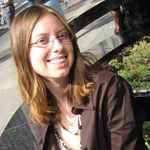 Lindsay Cibos
Lindsay Cibos
9/6/05
Interview with TDmonthly Magazine
I recently did an interview with TDmonthly Magazine. Now that it's online, I thought I'd go ahead and share the full-length version here. I've talked a little bit about my roots in comics before, but I think this goes into more detail. I always find it really interesting to see which comics influenced artists when they were younger, and how that shapes the type of comics they later create.
When did you first think about drawing comics?
Lindsay Cibos: I've always been drawing, ever since I was a kid. My first encounter with comics was during my middle school years, when I found a big bundle pack of Sonic the Hedgehog comics at a Toys "R" Us. That led me into looking for more comics, where I found other comics based around Disney properties, like Beauty and the Beast, and The Lion King. I became enthralled in the format, and it wasn't too long before I started making my own comics.
What's your background as an artist? What kind of training have you had?
LC: I'm mostly self-taught, but I've taken art classes in high school and some out-of-school classes on life drawing and cartooning at a local arts center. For the most part I’ve built my technique and style through practice, observation, trial and error, and just refining my skills from there.
What drew you to manga?
LC: Back in middle school, I found myself drawn towards several of the manga titles that were available at the time in a comic shop in the mall. Of the hundreds of comics available in the store, I only found myself attracted to maybe two or three titles, which happened to be the more girl-friendly manga titles out then, like Ranma ½, and Oh My Goddess (sadly, there wasn't a market for shoujo titles at the time). Later, through a middle school friend, I found out about another manga, Sailor Moon, and loved it. Through several connections I had as a teenager, I started buying the collected volumes of Sailor Moon, untranslated, directly from Japan. Armed with just a translation off the internet, I couldn't get enough of the story or the art style. When Sailor Moon finally came out domestically, I bought that up. I later did the same with Magic Knight Rayearth, Card Captor Sakura, Peach Girl, etc. These books were cute and fun, focused on girl’s issues, fashion, emotions, character interaction, and romance. They had a feminine charm to them that the male oriented American superhero comics just didn't have.
Who are your artistic inspirations as a kid?
LC: I was a big fan of many of the Disney animators like, Andreas Deja. I admired Kosuke Fujishima's work in Oh My Goddess. Upon discovery I became completely enamored with the amazing artwork of CLAMP. They were a huge influence on me. I also looked up to a number of Japanese fan artists I found on the Web. There was a lot of variety in their drawings, the way they colored and inked, and the way the reinterpreted character designs. It really broadened my horizons.
Whom do you admire today?
LC: Currently I look up to animation directors Hayao Miyazaki and Satoshi Kon for their storytelling and artistic sensibilities, as well as character designers like Shinya Hasegawa (Utena), Atsuko Ishida (Magic Knight Rayearth), Atsuko Nakajima (Ranma ½), and Ikoku Itoh (Sailor Moon). For the most part these artists specialize in beautiful, feminine, bright, and broadly appealing styles, that are detailed and flowing.
What makes Peach Fuzz uniquely appealing to girls?
LC: First and foremost, it's a cute and lighthearted tale about a girl and her pet ferret, with lots of cute animals and fun characters. Peach Fuzz focuses on character interaction, feelings, growth and understanding. There's a certain sort of realism in how the characters act, look, and feel. Plus the ferret, Peach, brings a fun, magical sense of otherness to the book. She can be pretty adorable as well.
When it comes down to it, shoujo manga tends to be less about fighting and adventure and more about aesthetics, feelings, and fun. Peach Fuzz has a bit of the former but plenty of the latter.
|